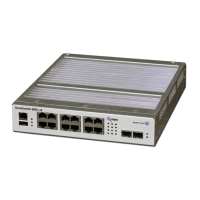OmniSwitch AOS Release 8 Network Configuration Guide December 2017 page 23-1
23 Configuring VRRP
The Virtual Router Redundancy Protocol (VRRPv2/VRRPv3) is a standard router redundancy protocol
supported in IPv4/IPv6, based on RFC 3768 and RFC 2787. It provides redundancy by eliminating the
single point of failure inherent in a default route environment. The VRRPv2/VRRPv3 router, which
controls the IPv4/IPv6 address associated with a virtual router is called the master router, and is
responsible for forwarding virtual router advertisements. If the master router becomes unavailable, the
highest priority backup router will transition to the master state. The OmniSwitch implementation of
VRRP also supports the collective management of virtual routers on a switch.
In This Chapter
This chapter describes VRRP and how to configure it through the Command Line Interface (CLI). CLI
commands are used in the configuration examples; for more details about the syntax of commands, see the
OmniSwitch AOS Release 8 CLI Reference Guide.
This chapter provides an overview of VRRP and includes information about the following:
• “Creating/Deleting a Virtual Router” on page 23-8.
• “Specifying an IP Address for a Virtual Router” on page 23-10.
• “Configuring the Advertisement Interval” on page 23-10.
• “Configuring Virtual Router Priority” on page 23-11.
• “Setting Preemption for Virtual Routers” on page 23-12.
• “Setting VRRP Traps” on page 23-13.
• “Configuring Collective Management Functionality” on page 23-14
• “Creating VRRP Tracking Policies” on page 23-17
• “Verifying the VRRP Configuration” on page 23-19.
• “VRRPv2 Application Example” on page 23-20.
• “VRRPv3 Application Example” on page 23-23.
Notes.
• Throughout the rest of this chapter, the feature name, “VRRP”, refers to both VRRPv2 and VRRPv3.
However, “VRRPv2” and “VRRPv3” are used explicitly to highlight any differences.
• This VRRPv3 implementation is based on the Internet Draft, Virtual Router Redundancy Protocol for
IPv6, September 2004.
• RFC 3768, which obsoletes RFC 2338, does not include support for authentication types. As a result,
configuring VRRP authentication is no longer supported in this release.

